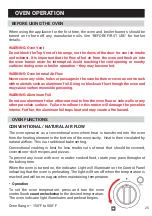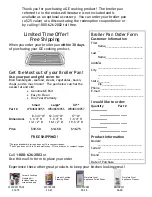
•
If the flame goes out prematurely while trying to ignite, turn the Burner Control Knob
clockwise to the off position. Wait at least 5 minutes for any gas to dissipate before
attempting to reignite. You may have to keep the Burner Control Knob pressed a little
longer.
•
The Range has an
Auto-Reignition feature
to accommodate for situations where
the flame goes out due to external causes such as a draft or door slamming. The
burners will automatically spark to reignite the flame, preventing gas leaking inadver-
tently.
IMPORTANT:
The appliance can be damaged if you:
- turn the knob without pushing in
- turn clockwise to turn on
- turn counterclockwise to turn off
TURNING ON IN THE EVENT OF A POWER FAILURE
If there is a power loss, you can ignite the flame manually, e.g., with a utility lighter.
1. Push in the Burner Control Knob and turn counterclockwise to the ‘HI’ position.
2. Keep the Knob pushed in and ignite the escaping gas-air mixture with a utility
lighter (that is a minimum 6” in length).
3. When lit, keep pushed in and turn the knob to the desired setting.
IMPORTANT: If the flame is blown out during a power failure, turn the knob immedi-
ately to OFF, as the burner will not automatically relight and gas may escape.
23
FLAME REGULATION
Once the flame is ignited, rotate the Burner Control Knob to regulate the flame.
•
To
reduce
the flames from a high to a low setting, push the corresponding knob in
and turn
counterclockwise.
•
To
increase
the flames from a low to a high setting, push in and turn the Burner
Control Knob
clockwise.
•
A smaller flame will give the best simmer results. Small flames offer precise cook-
ing performance for delicate foods, keeping food warm, melting chocolate or butter,
and for cooking that needs to cook over low heat for a long time.












































